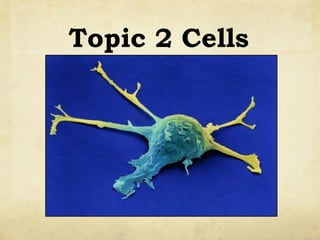Cells PPt
•Download as PPT, PDF•
1 like•1,482 views
The document discusses cell theory and evidence that supports it. It states that all living things are made of cells, cells come from other cells, tissues are made of individual cells, and organelles cannot live independently of cells. It provides examples of unicellular organisms carrying out life functions through metabolism, response, homeostasis, growth, reproduction, and nutrition. It also discusses exceptions like muscle cells and the debates around viruses.
Report
Share
Report
Share

Recommended
More Related Content
What's hot
What's hot (20)
Introduction to Biochemistry, cell and cell organelles

Introduction to Biochemistry, cell and cell organelles
Cell motility, cell excitation and cell differentiation

Cell motility, cell excitation and cell differentiation
Anatomy and Physiology Cell Transport and The Cell Cycle

Anatomy and Physiology Cell Transport and The Cell Cycle
Similar to Cells PPt
Similar to Cells PPt (20)
BIO120Concepts of BiologyUnit 2 Lecture Part One Cel.docx

BIO120Concepts of BiologyUnit 2 Lecture Part One Cel.docx
Cells PPt
- 10. Amoeba on the move!
- 11. Diatoms
- 12. Multicellular cells show emergent properties Emergent properties are ones that come about when individual parts of a system interact with each other. On their own, the individual parts cannot do what they can do together. The whole is greater than the sum of its parts. A cell can do much more than the individual parts or organelles can do. A protein can do more than the amino acids that its made up of.
- 13. Think of these 3 parts: 1. A small metal cup 2. A glass bowl 3. A piece of tugnsten wire Individually they have no function, but when they are together:
- 16. Conclusion Large organisms, the rate of exchange of substances with their surroundings occurs more slowly Cell radius (r) 0.25 units 0.5 units 1.25 units Surface area 0.79 units 3.14 units 7.07 units Volume 0.06 units 0.52 units 1.77 units SA: Volume 13.17:1 6.04:1 3.99:1
- 18. Comparisons of microscopes: Light microscope is more limited by its resolving power but allows observation of living organisms, movement and processes Transmission electron microscope is used to study the internal structure of the cell Scanning electron microscope is used to study the surface of a sample
- 20. Units of size
- 30. Embryonic stem cells/adult stem cells
- 34. Two kinds of cells: prokaryotic and eukaryotic Prokaryotic Small- 1 micron Lack nucleus and intermembranous systems Have cell wall DNA: one main circular chromosome and additional DNA in plasmid
- 35. Two kinds of cells: prokaryotic and eukaryotic Prokaryotic Eukaryotic Small- 1 micron Larger-10-100 microns Lack nucleus and intermembranous systems Organelles bound by membranes Have cell wall May have cell wall DNA: one main circular chromosome and additional DNA in plasmid DNA: in the nucleus, double stranded, no plasmid
- 39. Prokaryotic cells divide by binary fission
- 40. EUKARYOTIC CELLS
- 42. NUCLEUS
- 44. RIBOSOMES
- 46. ENDOMEMBRANE SYSTEM Endoplasmic reticulum
- 49. Golgi Apparatus
- 51. Lysosome